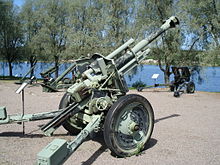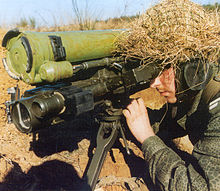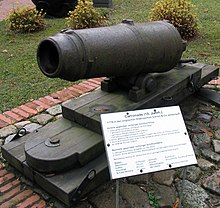Mount


A carriage (of French . L'affût , older l'affust the old French fust = stem, bar) is usually a mobile frame on which a gun can be mounted. A mounted weapon can be aimed more precisely and the recoil speed can be reduced.
history
The history of the gun mounts is closely linked to the history of the guns , as guns, unlike handguns, always require a solid base. The devices for vertical and lateral direction are integrated into this base. The simplest mounts, such as for the infantry weapon of the grenade launcher , consist only of a larger board with handles and holders for the barrel.
The first bombards were mounted on fixed frames made of wooden beams and the like. A trunnion on both sides of the pipe later enabled the height direction. With the development of field artillery , the carriages, still made of wood, were fitted with large wheels and were designed for horse-drawn trains. In the case of ship artillery , the large wheel mounts were more of a hindrance, here the size of the wheels was reduced and adapted to the lower deck heights. Articulated mounts were also used here later .
The gun was revamped for the march , i. In other words , the carriage was connected to the so-called Protze , a single-axle cart to which the horses were harnessed (guns are pulled backwards). In order to get the gun ready to fire again, it had to be blown off beforehand.
After steel gun barrels had proven themselves, the mounts were also made of steel. With the introduction of the barrel return and a ground spur attached to the mount , it became possible to significantly increase the rate of fire of the gun, as it no longer had to be repositioned and directed after each shot. In addition, the crew could be right next to the barrel when firing, and a protective shield placed in front of them meant they were less exposed to enemy fire.
Another development step was the invention of the spreading carriage, the carriage tail of which was folded up for transport, but spread in position so that you could shoot at an angle of 45 ° on each side without having to turn the entire gun. Previously, the side straightening angle was limited to around 5 ° per side.
Carriages running on railway tracks, the so-called railway guns, were used for very heavy artillery . These carriages cannot be rotated and are therefore dependent on the curves of the railroad tracks , on which they were driven in the required firing direction. Shooting curves were specially created if necessary.
The motorization enabled a self-propelled and therefore more heavily armored mount ( self-propelled gun ) for the field gun . The development reached until the invention of the tank , which in principle is a heavily armored mount with a rotating turret. Assault guns , however, are not equipped with rotating turrets.
At burials of high-ranking military personnel and at state funerals with military honors , a gun carriage with limber is often used to transport the coffin during the funeral procession.
Special forms
- Block mount: mount, the so-called “leg pieces”, ie stone cans, in a fixed frame, the “drawer”, can accommodate and thus make it more mobile. It has no trunnions . A distinction is made between the “lower load” ending in the tail of the carriage and the “upper load” with the gun lying on it.
- Burgundy mount : Only for light guns from the 15th to 16th centuries. An elongated piece of wood on which the gun is mounted (upper drawer), which in turn was movably mounted on a base. There were two horns at the end of the upper drawer. The recoil was absorbed by the pivot point of the upper chest and the directional horns.
- Wall mount : The invention of the trunnion made the wall mount possible. It consisted of two parallel wall frames that were firmly braced together and that together formed the carriage tail in their rear part (see picture). The gun barrel lay with the trunnion in a recess in the walls and was fixed at the top with iron straps so that it could not jump out of the recess. One improvement was the leveling screw. This was to remain the most common form of mount for many centuries. There were two forms of wall mounts. The older variant corresponds to the cannon shown in the first picture with parallel walls. In the newer version, "à l'anglaise" (English style), the mount tapered back and ended on "Protzöhr", the ring which the hooks of the limber was hooked. This type of carriage was also made of iron and was still in use during the First World War. When firing, the whole gun ran a few meters backwards and had to be brought into position each time. Towards the end of the 19th century, a movable spade was attached to the tail of the carriage , which was rammed into the ground and brought the gun back into position by spring force. The system did not work. The problem was only solved with the French Deport system, first implemented in the Canon de 75 mle in 1897 . The pipe was no longer directly on the carriage, but on a cradle on which it slid back, braked by an oil damper and brought forward again by compressed gas (System Deport) or spring force (Krupp). In addition to faster shooting, these newer mounts also allowed a certain amount of side correction.

- Pivot mount : In the 19th century , cannons and carronades were mounted on warships and in fortresses on so-called "pivot mounts". B. on the side wall, on a pin - the pivot - were mounted and had transverse rollers at the end, which enabled easier side alignment. Carronades also nolongerhad a cone , but an eyelet under the pipe, which enabled the height direction. Other guns were later "pivoted".
- Spreading carriage : Appeared at the beginning of the 20th century (first with the Italian Cannone da campagna M. 12 from 1912). It allowed the firing line to be lowered without laborious maneuvers when assembling and dismantling the gun.
- Cross mount: mount in cross shape under the gun, which is given a swivel range of 360 °. It is used in particular with heavy artillery and anti-aircraft guns .
- Multiple carriage: in the design of twin, triple and quadruple carriage, in which several tubes are mounted next to each other.
- Rotating ring mount: a round, rotating machine gun mount that is attached to vehicles on the driver's cab above the roof hatch.
- Self-propelled gun : includes all types in which a gun wasmade movableby a land vehicle - mostly tank hulls . In most versions, the gun can only be pivoted very little, which is why the vehicle itself has to be roughly aimed. The advantage of this mount is that almost no time is needed to assemble or dismantle the gun, so quick support or retreat is possible.
Other meanings
In medicine, the trolley on which the operating table is driven into the operating room is called a carriage.
In road haulage, carriage (often also " BDF carriage") describes a chassis on which exchangeable cargo containers, so-called swap bodies , are transported.
In the safe construction, a carriage is a receptacle into which the safe key is inserted. The carriage with the appropriate key is pushed into the safe door, after which the safe can be opened.
The pull-out cargo floor coffin in a hearse called gun carriage.
literature
- Franz Kosar: Artillery in the 20th century. The manual of the guns. Special edition. Bernard and Graefe, Bonn 2004, ISBN 3-7637-6249-3 .
- R. Böhm: The German Guns 1939-1945. Edited by Ferdinand von Senger and Etterlin , Bernard and Graefe, Bonn 1999, ISBN 3-7637-5989-1 .
- Otto Lueger : Lexicon of the whole technology and its auxiliary sciences , Vol. 6 Stuttgart, Leipzig 1908., S. 42-50. [1]
- Meyers Großes Konversations-Lexikon , Volume 12. Leipzig 1908, pp. 36–40. [2]



